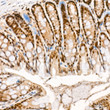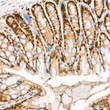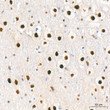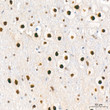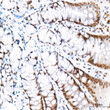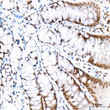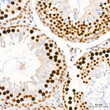| Tissue Specificity | Expressed in brain, thymus, CD4 T-cells, testis and epithelial ovarian cancer tissue. |
| Post Translational Modifications | Phosphorylated by CaMKK1 and CaMKK2 on Thr-200. Dephosphorylated by protein phosphatase 2A. Autophosphorylated on Ser-12 and Ser-13. Glycosylation at Ser-189 modulates the phosphorylation of CaMK4 at Thr-200 and negatively regulates its activity toward CREB1 in basal conditions and during early inomycin stimulation. |
| Function | Calcium/calmodulin-dependent protein kinase that operates in the calcium-triggered CaMKK-CaMK4 signaling cascade and regulates, mainly by phosphorylation, the activity of several transcription activators, such as CREB1, MEF2D, JUN and RORA, which play pivotal roles in immune response, inflammation, and memory consolidation. In the thymus, regulates the CD4(+)/CD8(+) double positive thymocytes selection threshold during T-cell ontogeny. In CD4 memory T-cells, is required to link T-cell antigen receptor (TCR) signaling to the production of IL2, IFNG and IL4 (through the regulation of CREB and MEF2). Regulates the differentiation and survival phases of osteoclasts and dendritic cells (DCs). Mediates DCs survival by linking TLR4 and the regulation of temporal expression of BCL2. Phosphorylates the transcription activator CREB1 on 'Ser-133' in hippocampal neuron nuclei and contribute to memory consolidation and long term potentiation (LTP) in the hippocampus. Can activate the MAP kinases MAPK1/ERK2, MAPK8/JNK1 and MAPK14/p38 and stimulate transcription through the phosphorylation of ELK1 and ATF2. Can also phosphorylate in vitro CREBBP, PRM2, MEF2A and STMN1/OP18. |
| Protein Name | Calcium/Calmodulin-Dependent Protein Kinase Type IvCamk IvCam Kinase-Gr |
| Database Links | Reactome: R-HSA-111932Reactome: R-HSA-2151201Reactome: R-HSA-442729Reactome: R-HSA-9022535Reactome: R-HSA-9022692Reactome: R-HSA-9617324 |
| Cellular Localisation | CytoplasmNucleusLocalized In Hippocampal Neuron NucleiIn SpermatidsAssociated With Chromatin And Nuclear Matrix |
| Alternative Antibody Names | Anti-Calcium/Calmodulin-Dependent Protein Kinase Type Iv antibodyAnti-Camk Iv antibodyAnti-Cam Kinase-Gr antibodyAnti-CAMK4 antibodyAnti-CAMK antibodyAnti-CAMK-GR antibodyAnti-CAMKIV antibody |
Information sourced from Uniprot.org








